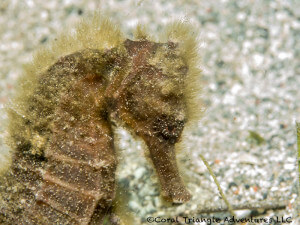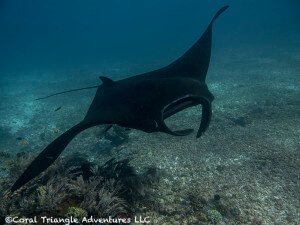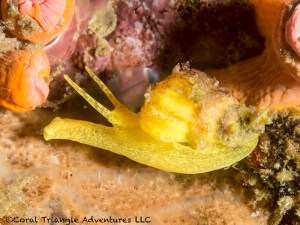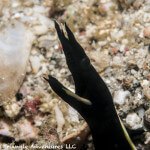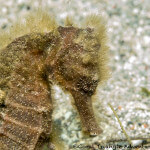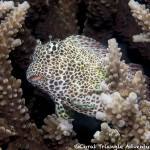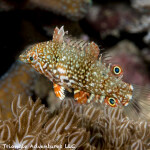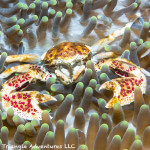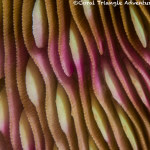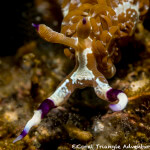
Komodo NP Snorkeling Tour, 2015 Trip Report
Our recent snorkeling trip to Komodo NP was outstanding…but honestly having been there many times before, I am not at all surprised. We boarded our boat in Labuan Bajo, Flores the gateway into the park. Our first stop was at Sabayor Island where we snorkeled some of the healthiest hard and soft coral gardens in the area. Strong currents helped whisk us over the reefs and through enormous schools of blue-green chromis (numbering in the thousands)!
Our next day was at Gili Lawa Darat and the dive/snorkel site called Shotgun. The snorkel area at Gili Darat offers thechance to snorkel on a magnificent shallow reef with variety of habitats adjacent to the main reef that included extensive sand and mud patches, a channel between Gili Darat and Komodo Island, and at high tide, mangroves. For me, the sand/mud patches have always delivered the more interesting and rare creatures like seahorses and Randall’s jawfish. The seahorse we found had patches of algae along the head and back giving it a true horse-like appearance. Shotgun is the channel between Gili Darat and Gili Lawa Laut. Water moves swiftly through the channel and attracts a variety of fishes including fusiliers, surgeonfishes, jacks, snapper, chubbs, and mantas. Turtles are also common in the area. Though often in the channel, we did have a manta ray on the east side just at the edge of the channel entrance. We’ll take it :-)!
On our third day we continued westward and snorkeled at Gili Banta. The snorkeling here is always a treat with reefs that boast great examples of corals that are exposed to heavy wave action. Though a bit windy, we had fun on the reef and marveled at the enormity of some of the colonies.
We headed east on the fourth day and stopped first at Batu Monco, a bay located on the northwestern tip of Komodo Island. This quiet bay has some amazing shallow coral gardens and also the chance to snorkel along a deeper slope where lots of big fishes like snapper, unicornfishes, triggerfishes, and groupers hang out. Most of the guests loved the highlight; two cuttlefish that posed tirelessly for their portraits. In the afternoon, we stopped by Makassar reef and snorkeled with two of the manta rays that happened to be visiting the reef for a good cleaning. We watched as a completely black individual remained motionless above a small coral outcropping while dozens of Klein’s butterflyfish and several cleaner wrasse roamed over her skin to clean her of parasites.
The next two days revolved around snorkel sites near Komodo NP and we included a visit to the island to see it’s famed inhabitant: the Komodo dragon. The world’s largest lizard measures up to 3.5m in length and can weigh over 80 kg. We saw several as they were going about their daily business of resting and roaming but the highlight was a tiny juvenile no longer than a half-a-meter peeking out of a hole in a dead sago tree. As juveniles, they are food items for the adults and must seek refuge in the trees. They spend much of their early life in trees feeding upon insects, smaller lizards, and bird eggs. After a few years, they are large enough to walk the earth and are capable of defending themselves against the larger adults.
Our time in Horseshoe bay, now on the final few days of the trip, was spectacular. Probably the best news of all upon entering the scenic ancient caldera was that the water temperature was a balmy 25 degree Celsius…warm for the bay! We snorkeled Yellow Wall and Torpedo Alley and both delivered on the critters (nudibranchs aplenty!) and on the color (amazing colors bursting from the cnidarians, tunicates, and sponges).
Our final days were spent around Siaba Kecil, Siaba Besar, Tatawa, and Sabayor. What a way to finish! Some of the best shallow hard coral gardens in the entire park, if not the entire world! Just check out the pics! We cannot wait to come back, well, next month for two back-to-back departures to this unique location in the heart of the Coral Triangle.
- Juvenile ribbon eels…
- This seahorse…
- A leopard blenny…
- A juvenile leopard wrasse…
- Porcelain crabs…
- Coral close-ups…
- Cuttlefish…
- Close-up of the…

